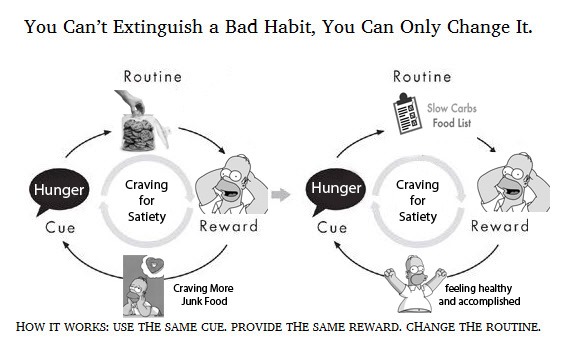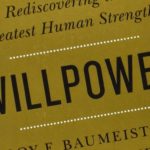
The Power of Habit (Summary) – Charles Duhigg
Notes:
The book is narrated in a storytelling style with different peoples true stories and is ‘scientific-based’. The story part has been skipped in the summary below.
The habit loop is Cue > Routine > Reward. You can keep the Cue and Reward and change the routine. E.g. if there is not so much bacon in the fridge, not much bacon will be eaten. If there are healthy snacks near the couch, they will get nibbled instead.
If the cue changes the slightest bit, it could throw the whole loop off.
Cue’s will usually fall into 5 categories:
1. Time e.g. your wake up routine.
2. Location e.g. eating cookies when you passed them.
3. Preceding event e.g. getting a ping before checking messages.
4. Emotional State e.g. comfort eating, shopping. (Hard one to change)
5. Other people e.g. birds of a feather.
The Framework
• Identify the routine.
• Experiment with rewards.
• Isolate the cue.
• Have a plan.
Amazon #ads
The basal ganglia is where the habits are stored while the rest of the brain goes to sleep and the spike of good stuff first happens at the reward part of the loop but once the habit is formed, the spike moves to the cue part of the loop. This is why the routine can be changed.
Claude Hopkins got people brushing their teeth, eating Quaker oats every day and other habits using the habit loop. The cue was something impossible to ignore (tooth film, being more beautiful because of a better-looking smile).
The 2 basic rules (read on for the secret 3rd rule):
1. Find a simple and obvious cue.
2. Clearly define the rewards.
Success with new exercise routines happened after a specific cue was chosen, such as running as soon as they get home from work and a reward like a beer or guiltfree television.
Dieting food habits need a predetermined cue such as planning menus in advance, and simple rewards when they stick to their intentions.
Habits create neurological patterns where a subconscious craving is created. This craving cannot be diverted from until the habit loops are completed. The sight of cigarettes triggers a craving for nicotine. That number of notification creates a craving to ‘have to’ read that email or see the notification.
Particularly strong habits produce addiction-like reactions so that “wanting evolves into obsessive craving” that can force our brains into autopilot, “even in the face of strong disincentives, including loss of reputation, job, home, and family.”
People who habitually exercise gave them a ‘reward’ of feeling good or a sense of achievement. They grew to expect and crave the endorphins and other neurochemicals a workout provided.
Even though toothpastes have irritants that make your mouth tingle, people bought it just for that craving as it made them feel like the paste was working. The same way shampoo and laundry detergent don’t really have to foam so much or at all.
Anyone can use this basic formula to create habits of her or his own. Want to exercise more? Choose a cue, such as going to the gym as soon as you wake up, and a reward, such as a smoothie after each workout. Then think about that smoothie, or about the endorphin rush you’ll feel. Allow yourself to anticipate the reward. Eventually, that craving will make it easier to push through the gym doors every day.
Want to craft a new eating habit? When researchers affiliated with the National Weight Control Registry—a project involving more than six thousand people who have lost more than thirty pounds—looked at the habits of successful dieters, they found that 78% of them ate breakfast every morning, a meal cued by a time of day. But most of the successful dieters also envisioned a specific reward for sticking with their diet—a bikini they wanted to wear or the sense of pride they felt when they stepped on the scale each day—something they chose carefully and really wanted. They focused on the craving for that reward when temptations arose, cultivated the craving into a mild obsession. And their cravings for that reward, researchers found, crowded out the temptation to drop the diet. The craving drove the habit loop
Alcoholics Anonymous provides a method for attacking the habits that surround alcohol use. The program forces people to identify the cues and rewards that encourage their alcoholic habits, and then helps them find new behaviors. When you make a self-inventory, you’re figuring out all the things that make you drink. And admitting to someone else all the bad things you’ve done is a pretty good way of figuring out the moments where everything spiraled out of control.
If you want to stop smoking, ask yourself, do you do it because you love nicotine, or because it provides a burst of stimulation, a structure to your day, a way to socialize? If you smoke because you need stimulation, studies indicate that some caffeine in the afternoon can increase the odds you’ll quit. Plenty of studies found that identifying the cues and rewards they associate with cigarettes, and then choosing new routines that provide similar payoffs—a piece of Nicorette, a quick series of push-ups, or simply taking a few minutes to stretch and relax—makes it more likely they will quit.
Some people need another ingredient – belief.
Alcoholics who practiced the techniques of habit replacement could often stay sober until there was a stressful event in their lives—at which point, a certain number started drinking again, no matter how many new routines they had embraced. However, those alcoholics who believed, like John in Brooklyn, that some higher power had entered their lives were more likely to make it through the stressful periods with their sobriety intact.
It wasn’t God that mattered, the researchers figured out. It was belief itself that made a difference. Once people learned how to believe in something, that skill started spilling over to other parts of their lives, until they started believing they could change. Belief was the ingredient that made a reworked habit loop into a permanent behaviour.
For habits to permanently change, people must believe that change is feasible. The same process that makes AA so effective—the power of a group to teach individuals how to believe—happens whenever people come together to help one another change. Belief is easier when it occurs within a community.
For a habit to stay changed, people must believe change is possible. And most often, that belief only emerges with the help of a group.
If you focus on changing or cultivating keystone habits, you can cause widespread shifts. However, identifying keystone habits is tricky. To find them, you have to know where to look. Detecting keystone habits means searching out certain characteristics. Keystone habits offer what is known within academic literature as “small wins.” They help other habits to flourish by creating new structures, and they establish cultures where change becomes contagious.
Small wins are a steady application of a small advantage. Once a small win has been accomplished, forces are set in motion that favour another small win. Small wins fuel transformative changes by leveraging tiny advantages into patterns that convince people that bigger achievements are within reach.
Amazon #ads
Keystone habit—food journaling—created a structure that helped other habits to flourish. Six months into the study, people who kept daily food records had lost twice as much weight as everyone else.
When kids learn habits for delaying their cravings, those habits spill over to other parts of life. (Marshmallow experiment)
Willpower plays a big part on a lot of your habits. Self-discipline and willpower spill over to all areas of life.
Read more about Willpower here.
Recovering patients who were asked to perform some kind of activity or exercise as soon as possible and regularly recovered more than just physically. The ones that gave up after feeling pain took much longer to get back on track. The successful ones wrote out a plan and stuck to it. The writing out of the plan makes a big difference. It helps against reflex actions. So Cue > Routine > Reward where the routine is a reflex action vs. where the routine is a planned response.
The patients’ plans were built around inflection points when they knew their pain—and thus the temptation to quit—would be strongest. The patients were telling themselves how they were going to make it over the hump.
Routines provide the hundreds of unwritten rules that companies need to operate. They allow workers to experiment with new ideas without having to ask for permission at every step. They provide a kind of “organizational memory,” so that managers don’t have to reinvent the sales process every six months or panic each time a VP quits. Routines reduce uncertainty—a study of recovery efforts after earthquakes in Mexico and Los Angeles, for instance, found that the habits of relief workers (which they carried from disaster to disaster, and which included things such as establishing communication networks by hiring children to carry messages between neighborhoods) were absolutely critical, “because without them, policy formulation and implementation would be lost in a jungle of detail. But among the most important benefits of routines is that they create truces between potentially warring groups or individuals within an organization.
Routines create truces that allow work to get done
Story of how routines and truces can go the opposite way if you follow it blindly.
Shopping products are strategically placed. If we start our shopping sprees by loading up on healthy stuff, we’re much more likely to buy Doritos, Oreos, and frozen pizza when we encounter them later on.
Consumers sometimes act like creatures of habit, automatically repeating past behaviour with little regard to current goals.
People’s buying habits are more likely to change when they go through a major life event. Having a baby is the greatest life event. Pregnant women and new couples are the biggest consumers.
Companies like Target use this information so they know exactly what trimester a woman is on and what she will buy or need… and then some.
There is evidence that a preference for things that sound “familiar” is a product of our neurology. Our brains crave familiarity in music because familiarity is how we manage to hear without becoming distracted by all the sound. When Celine Dion releases a new song—and it sounds like every other song she’s sung, as well as most of the other songs on the radio—our brains unconsciously crave its recognizability and the song becomes sticky. (Story of how Outkast’s – Hey Ya was not a familiar sound so they sandwiched the song between popular and liked songs to get familiarity.
So the trick is to dress something new in old clothes, and making the unfamiliar seem familiar.
Soldiers were more likely to eat food, whether familiar or unfamiliar when it was prepared similar to their prior experiences and served in a familiar fashion.
Retention was driven by emotional factors, such as whether employees knew members’ names or said hello when they walked in. People, it turns out, often go to the gym looking for a human connection, not a treadmill.
Movements
1. A movement starts because of the social habits of friendship and the strong ties between close acquaintances.
2. It grows because of the habits of a community, and the weak ties that hold neighbourhoods and clans together.
3. And it endures because a movement’s leaders give participants new habits that create a fresh sense of identity and a feeling of ownership.
Usually, only when all three parts of this process are fulfilled can a movement become self-propelling and reach a critical mass.
The habits of peer pressure have something in common. They often spread through weak ties instead of strong friendships. And they gain their authority through communal expectations. If you ignore the social obligations of your neighbourhood, if you shrug off the expected patterns of your community, you risk losing your social standing. You endanger your access to many of the social benefits that come from joining the country club, the alumni association, or the church in the first place. So if you don’t give the caller looking for a job a helping hand, he might complain to his tennis partner, who might mention those grumblings to someone in the locker room who you were hoping to attract as a client, who is now less likely to return your call because you have a reputation for not being a team player. On a playground, peer pressure is dangerous. In adult life, it’s how business gets done and communities self-organize.
For an idea to grow beyond a community, it must become self-propelling. And the surest way to achieve that is to give people new habits that help them figure out where to go on their own.
Movements don’t emerge because everyone suddenly decides to face the same direction at once. They rely on social patterns that begin as the habits of friendship, grow through the habits of communities, and are sustained by new habits that change participants’ sense of self.
To modify a habit, you must decide to change it. You must consciously accept the hard work of identifying the cues and rewards that drive the habits’ routines and find alternatives. You must know you have control and be self-conscious enough to use it—and every chapter in this book is devoted to illustrating a different aspect of why that control is real.
Amazon #ads
Contents
PROLOGUE – The Habit Cure
PART ONE – The Habits of Individuals
1. THE HABIT LOOP – How Habits Work
2. THE CRAVING BRAIN – How to Create New Habits
3. THE GOLDEN RULE OF HABIT CHANGE – Why Transformation Occurs
PART TWO – The Habits of Successful Organizations
4. KEYSTONE HABITS, OR THE BALLAD OF PAUL O’NEILL – Which Habits Matter Most
5. STARBUCKS AND THE HABIT OF SUCCESS – When Willpower Becomes Automatic
6. THE POWER OF A CRISIS – How Leaders Create Habits Through Accident and Design
7. HOW TARGET KNOWS WHAT YOU WANT BEFORE YOU DO – When Companies Predict (and Manipulate) Habits
PART THREE – The Habits of Societies
8. SADDLEBACK CHURCH AND THE MONTGOMERY BUS BOYCOTT – How Movements Happen
9. THE NEUROLOGY OF FREE WILL – Are We Responsible for Our Habits?
Appendix
A Reader’s Guide to Using These Ideas
Acknowledgements
A Note on Sources
Note





